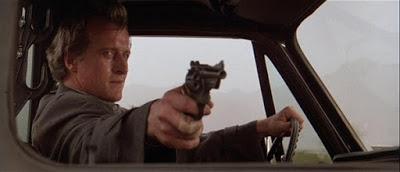Format: Streaming video from HBO Go on rockin’ flatscreen.

There’s a reason that I rewatch movies I’ve seen before for this blog. That reason is that my opinion sometimes changes regarding a particular film. If you’d asked me a year ago what I thought of The Hitcher from 1986, I’d have told you it was a disturbing horror film that goes to some really dark places and does it really well. Seeing it again now, this is a film that retains none of the power that I would have attributed to it and is instead just a thinly connected series of sadistic events. I looked forward to revisiting The Hitcher and now I wonder exactly what I saw in it. Even the scene, the one that everyone remembers, comes across as just being mean-spirited and ugly.
Here’s how this works: Jim Halsey (C. Thomas Howell) is driving a car from Chicago to San Diego to deliver it to the man who bought it. One night, he almost falls asleep at the wheel. Worried that he might actually fall asleep, he picks up a hitchhiker named John Ryder (Rutger Hauer), hoping that conversation might keep him on his toes. Unfortunately for Jim, John Ryder is a psychopath who needed a ride because he brutally murdered the driver of the last car he was in, promising to do the same to Jim. When he sees an opportunity, Jim kicks Ryder out of his car and drives away.
What follows is basically Duel. Ryder shows up frequently, threatening and taunting Jim. The difference here is that Ryder also leaves a trail of bodies along the way, all of which appear to be the responsibility of Jim, making him a wanted fugitive. Each time Jim gets picked up by the police, in fact, Ryder shows up and kills the police, setting Jim free once again. Lather, rise, repeat for 98 minutes.
One of the real problems with The Hitcher is that a great deal happens here specifically for plot reasons, because things need to happen a particular way for the story to work even though there’s no real reason things would happen that way. A case in point is the character of Nash (Jennifer Jason Leigh). Early in the film, Jim encounters her working at a truck stop. They talk for a minute, Jim telling her that he’s headed to California and her saying she’s thought about going there. Half an hour later or so, Jim sneaks onto a bus to escape pursuit…and Nash is on the bus. The only reason Nash is on that bus is because it sets up the big scene between Jim, Ryder, and her toward the end. She’s there because the plot needs her there, not because it makes any real sense for her character.
Here’s the thing—I get why I liked this when I was younger. It’s aggressive and disturbing in places. In a lot of ways, it’s a mid-80s version of the sort of movie I would hear about from my brother—the sort of thing that you knew was dangerous in some way and that you knew you weren’t supposed to watch at 12 or 13 and would hear about from an older sibling or a friend’s brother. My brother Tom loved stuff like that. Things like Faces of Death and The Last House on the Left that had reputations of being unsavory. I’d hear about these as a kid and both be intrigued by them and scared of them. I was 19 when The Hitcher was released, though, which meant I was old enough to see one of those dangerous movies. Of course I liked it. It played entirely into that mythos of being no longer forbidden but still unsafe.
So, looking back, I completely get it. That this is still considered so highly among horror movie viewers and fans only indicates to me that I’m not alone in having had that experience. Here’s the thing, though—I wonder how many people who rate this as a great horror film have watched it lately. Having seen it again, I really have to question the love that it gets, and while I can’t know for sure, I’m pretty sure that the love it gets comes from it feeling so transgressive in so many ways despite showing very little blood and virtually no gore. It seems like it’s captured a particular evil on film, and that’s interesting.
Interesting is nice, but The Hitcher just isn’t very good. There’s an attempt to create some sort of psychic connection between Jim and Ryder, but since this is merely implied and not elaborated on in any way, what we’re left with is a really evil dude who seems to magically show up around this other guy on a consistent basis. Again, this happens because the plot needs it to happen; the film won’t work unless it does, but these things happen for no discernable reason within the story. Hey, we need Ryder to show up. How does he know where to be? Doesn’t matter; he just shows up.
There are some good moments here, moments that rescue The Hitcher from being entirely pointless. Those moments, while classic in ways (the finger in the French fries, the confrontation in the truck stop booth, and of course “the scene” that everyone will remember) aren’t enough to turn this into a film that works, though. Ultimately, The Hitcher is more mean-spirited than menacing, more sadistic than scary, and ugly instead of unforgettable.
Why to watch The Hitcher (1986): Like it or not, it’s considered a classic and formative for the genre.
Why not to watch: It’s an exercise in sadism.
